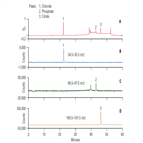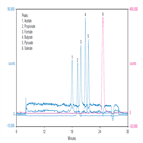Find methods for your needs
Refine by Feature
Displaying 1-4 of 4 results for Tag: MSQ
AN1112: Determination of Anions in Breast Milk
Instrument Type: ICMSBreast milk is the primary source of nutrition for newborns before they are able to eat and digest other foods, so there is a close correlation between breast milk quality and infant health. In addition to proteins and vitamins, the ionic elements such as sodium, potassium, calcium, magnesium, chloride, and nitrate in breast milk also are important for infant health. However, consumption of breast milk that contains a high concentration of these ions could lead to health issues. IC is an efficient means to determine anions. An ICS-6000 can be used for this application.
Measuring Phytosterols in Health Supplements by LC/MS
Instrument Type: LCMSPlant sterols, phytosterols, are claimed to help lower cholesterol levels in humans. In the year 2000, the United States Food & Drug Administration (US FDA) approved a health claim relating phytosterol ester or phytostanol ester consumption to reduced risk for coronary heart disease. Thus, there is increased interest in qualitative and quantitative analysis of phytosterols in food products. Phytosterols are typically measured by gas chromatography after derivatization. In this study, phytosterols were injected onto an LC-MS for direct analysis.
离子色谱-质谱联用测定面包中溴酸盐
Instrument Type: IC溴酸盐是一种广泛用作烘焙面包的添加剂,在面团的发酵、醒发及焙烤工艺过程中可以起到一种缓慢氧化的作用。它一直被烘焙业视为价廉物美的面团氧化剂而广泛应用于食品行业。1992年世界卫生组织确认溴酸根是一种氧化性致癌物,可导致生命组织发生癌变。目前溴酸根检测有较多的报道,如毛细管电泳光度法、离子色谱抑制电 导法、离子色谱蒸发光散射检测法、离子色谱-等离子体发射-质谱联机检测 法、气相色谱质谱检测法及离子色谱柱后衍生法,但面制品添加复杂的添加 剂,而其电导检测的非特异性,会导致测定结果的假阳性,并且对于样品中 痕量溴酸盐难以准确定量。 离子色谱-质谱联机检测法,可以有效降低复杂背景对溴酸根测定的影 响,排除假阳性的可能,具有快速、直接进样等优点,在实际样品分析中得 到较好的应用。
AN1000: Direct Determination of Small Organic Acids in Sea Water by IC-MS
Instrument Type: ICMSThis application demonstrates a 2D-IC-MS system that allows low levels of small organic acids (C1–5) to be analyzed in a high-ionic-strength matrix. The first dimension of the system separates the low-level analytes from the matrix while the second dimension resolves each of the target analytes. The mass spectrometer confirms identity and achieves low detection limits for a sensitive and selective assay. No special sample preparation was required and the results show good precision and reproducibility.




